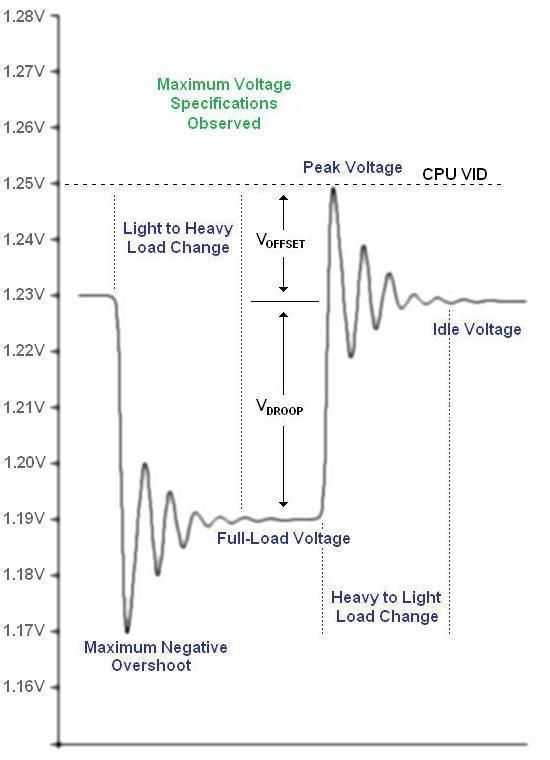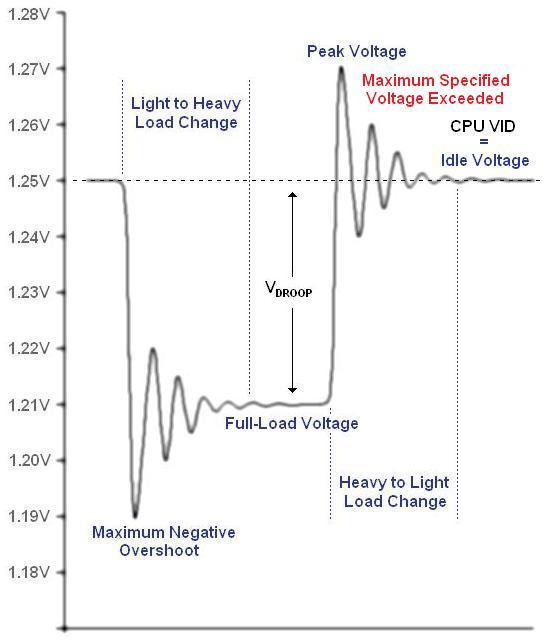Overclocking Intel's New 45nm QX9650: The Rules Have Changed
by Kris Boughton on December 19, 2007 2:00 AM EST- Posted in
- CPUs
Intel Processor Power Delivery Guidelines
If you've ever overclocked a system, chances are that at some point or another you've had opportunity to become upset with your Vdroop "problem." Some users, confused as to why their system refuses to exactly match actual processor supply voltage to the value specified in BIOS, are quick to blame the quality their motherboard; still others find fault with the difference noted between their board's idle and full-load processor supply voltages. Actually, load line droop (Vdroop) is an inherent part of any Intel power delivery design specification and serves an important role in maintaining system stability. In most cases, comments regarding unacceptable power delivery performance are completely unfounded. To make matters worse, unjustified negative consumer perception surrounding this often misunderstood design feature eventually forced a few motherboard manufacturers to respond to enthusiasts' demands for action by adding an option in their BIOS that effectively disables this important function.
Based on the currently running tasks, processor load can vary significantly during system operation. The voltage regulator module (VRM) circuit closely regulates CPU supply voltage by sensing instantaneous changes in processor loading and then responds by varying the individual on-time for a bank of power MOSFETs used to charge a multi-phased LC network. This LC network is responsible for providing all of the power demanded by the processor. If the VRM senses a decreasing supply voltage, it provides more current; the opposite is true in the case where voltage is rising. This cycle of sense-and-correct, known as negative feedback, can occur at that rate of thousands to millions of times per second, depending on the particular circuit's switching frequency.

Just like CPU power, CPU supply current increases quickly at higher frequencies
During periods of high CPU demand, the VRM circuit works hard to supply the current required by the processor. However, as soon as that load is gone, the VRM circuit must act quickly in order to reduce the current supply to the level needed to match the new demand. Because it's impossible for the VRM circuit to respond instantaneously, the larger the load change the greater the maximum potential peak overshoot voltage. Controlling the magnitude of these peak values is critical for maintaining system stability. By positioning the processor's no-load (idle) voltage level higher during periods of light loading, it's possible to sustain a larger negative voltage dip without crossing the processor's lower specified voltage limit. In addition, "drooping" the load voltage as a function of supply current allows the VRM to effectively limit the maximum positive peak overshoot voltage (experienced during a heavy to light load transient) to a value below the maximum allowable CPU voltage. This resulting control system ensures the processor supply voltage, regardless of CPU load, never violates a specified limit. The following figure should help to illustrate these concepts.

As intended, Voffset and Vdroop ensure that the supply voltage never exceeds CPU VID
The CPU VID setting establishes the absolute maximum allowable processor supply voltage experienced during transient conditions and is not the target idle voltage. We hope this statement draws attention to this important distinction, as many believe the opposite to be true - a mistake all too commonly made. Together, Vdroop and Voffset ensure that the peak CPU supply voltage seen during heavy to light loading changes remains well below the established maximum. If you determine that 1.17V, as in the case above, is not sufficient for maintaining CPU stability under load, simply increasing the CPU VID does correct the problem. Let's now examine how the system responds if we remove Voffset.

Voltage oscillations while leaving heavy load can cause problems with no Voffset
As we can see, the system exceeds maximum allowable processor voltage whenever any heavy to light load transient is significant enough to warrant one or more voltage excursions above the CPU VID value. Even worse, this all happens without the user's knowledge. Again, removing Voffset completely undermines the purpose of the VID setting - which establishes the maximum CPU voltage, not the target value.










56 Comments
View All Comments
Aivas47a - Wednesday, December 19, 2007 - link
Great article. You guys have really been distinguishing yourselves with in-depth work on overclocking the last few months: exploring obscure bios settings, tinkering with "extreme" cooling -- keep it up!My experience with a qx9650 so far is very similar to yours: easy scaling to 4 ghz, difficult scaling after that with 4.2 ghz being the practical max for regular operation (folding, etc.).
One issue I will be interested to see you address in the future is fsb overclocking on yorkfield. So far I am seeing yorkfield top out at lower fsb (450-460) than was possible for kentsfield on a comparable P35 or X38 platform. That is not so significant for the unlocked Extreme Edition chips, but could make it difficult to achieve the magic 4 ghz with the q9550 and especially the q9450.
Aivas47a - Wednesday, December 19, 2007 - link
Great article. You guys have really been distinguishing yourselves with in-depth work on overclocking the last few months: exploring obscure bios settings, tinkering with "extreme" cooling -- keep it up!My experience with a qx9650 so far is very similar to yours: easy scaling to 4 ghz, difficult scaling after that with 4.2 ghz being the practical max for regular operation (folding, etc.).
One issue I will be interested to see you address in the future is fsb overclocking on yorkfield. So far I am seeing yorkfield top out at lower fsb (450-460) than was possible for kentsfield on a comparable P35 or X38 platform. That is not so significant for the unlocked Extreme Edition chips, but could make it difficult to achieve the magic 4 ghz with the q9550 and especially the q9450.
Doormat - Wednesday, December 19, 2007 - link
Though its somewhat disappointing on the rumors that Intel has postponed the launch of their QuadCore desktop chips from January to March.Sunrise089 - Wednesday, December 19, 2007 - link
I agree with everyone else - really top notch stuff here.1 glaring typo though, from the first page: "Moving to a smaller node process technology allows for the potential of one or two things to happen. " - the "or" should be an "of"
ChronoReverse - Wednesday, December 19, 2007 - link
It seems that ATI cards have less of a drop going from XP to Vista (down to zero and even negative sometimes). It might be instructive to use that for the charts that compare Vista to XP for 3D (e.g., the 3Dmark06 benchmark).melgross - Wednesday, December 19, 2007 - link
Capacitors have their capacitance turned into reactance at higher frequencies. Anything that qualifies, in a circuit, as a capacitor, such as two wires riding in parallel, will have, to a greater or lesser extent, the same problem in the design.Reactance rolls off high frequencies. More power is required to offset that.
This is the same problem whether dealing with low frequencies in an audio circuit (where it may be less of a problem), or a high performing computer. It's almost impossible to eliminate all stray capacitance from a circuit, and more circuitry becomes capacitive at higher frequencies. This will only increase as a problem as we get to smaller processes, such as 32nm.
andyleung - Wednesday, December 19, 2007 - link
I am very interested in the performance of these new CPUs. They are Quad-Core and they are good enough to perform some heavy duty business tasks. Wondering how they work with JEE performance.BLHealthy4life - Wednesday, December 19, 2007 - link
This article is a perfect example of what makes Anandtech so great. Anandtech has the most brilliant and most technically savvy guys on the internet.Very rarely will you fine any other website review pieces of hardware with such intricate detail for hardware specs and the technology behind it.
Great work guys!
BL
kkak52 - Wednesday, December 19, 2007 - link
really an informative article.... good work!Bozo Galora - Wednesday, December 19, 2007 - link
A 10+ article, especially the vdroop section.Its nice to see something on AT like the old days thats cuts through the BS and actually gives real usable info.
Quite a tour de force.
Nice work.